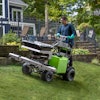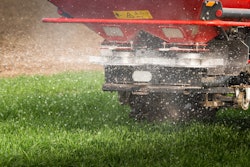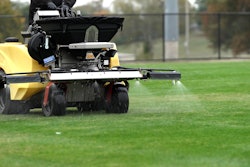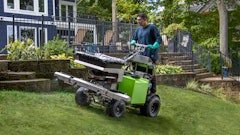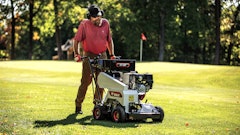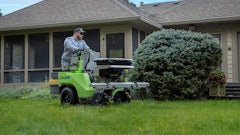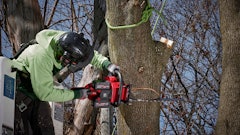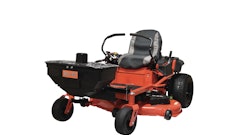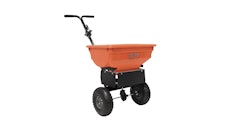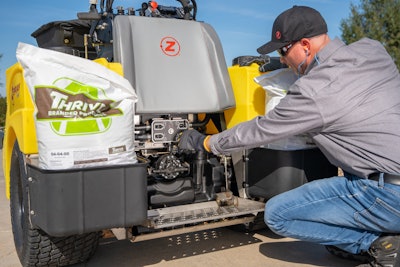
By maintaining spreader-sprayers ahead of the busy season, lawn care operators will be sure to gain—more time, more money and more peace of mind.
“Preseason maintenance is important because the beginning of the season is often the busiest time of the year, and it's never good to have an issue that could have been prevented set you back from the start,” says Kodi Quinlisk, sales representative at Steel Green.
Experts delve into the most common maintenance issues and explain how to solve them.
Maintenance must do's
Cleaning and storage
Properly maintaining a spreader-sprayer starts with storage in the winter. If the machine is not properly maintained, cleaned and prepared for winter, maintenance issues may start to pile up like the snow outside.
“Preseason maintenance actually starts at the end of your last season,” Quinlisk says. “A common mistake that we see is customers not properly cleaning their machines out and cleaning all of the product off of them. This leads to multiple issues from corrosion to issues with the spray pumps and other components not working properly.”
For example, water in the spray system can freeze and damage components, leaving old fuel in the machine can lead to poor engine or carburetor performance and leaks caused by old, cracking hoses, or belt wear and/or breakage can occur simply because of weathering and the age of the parts, says Andy Walters, national accounts manager, Z Turf Equipment.
“Improper storage affects spreader-sprayers in a number of ways that are both seen and unseen,” Walters says. “It’s easy to see the expedited weathering improper storage creates on the surface of the machine, but failing to prepare the spray system, for example, can cause damage to vital components that are very expensive to replace.”
To ensure the machine will start at the beginning of the season, Middleton recommends treating the gas before storing the machine.
“Ethanol is brutal to carburetor,” says Brian Middleton, technical manager for PermaGreen. “You can use a fuel stabilizer or for the engineered fuels that are out there. There’s not ethanol in them, so you can put that in during wintertime, put the machine away, and odds are that it will start in the spring.”
Quinlisk adds that machines should be stored in a dry place to prevent water from damaging the components.
Finally, Walters says lawn care operators should take note of any rust or corrosion that may have occurred during storage.
“Corrosion on the frame or components is typically an indicator that the machine wasn’t cleaned sufficiently prior to storage,” Walters says.
Flush the machine
Walters notes that most machines need to be cleaned and flushed thoroughly to remove any liquid or granular material from not just from the spread and spray systems, but also from the machine itself. Typically, an antifreeze is also added to the spray system to ensure no damage occurs to the spray system and its components due to freeze-thaw cycles.
“A lot of chemicals go through these tanks, and you need to make sure you’re getting that old material out of them,” Middleton says. “If you don’t flush out those chemicals, they can get stuck in the lines of the machine, and you certainly don’t want to go out and start doing customers’ properties with partially clogged lines.”
Walters adds that the service manual typically details the proper procedures for storing machines in the off-season and preparing them for use after storage.
Check tire pressure
Insufficient tire pressure can dramatically affect the tracking, handling and stability of a spreader-sprayer in operation, Walters says.
Middleton recommends checking the tire pressure before storage and after storage.
“If you top off your tire pressure in the winter, when spring comes, if your tires are down in pressure, that’s something you want to address immediately,” Middleton says. “If you’re off by a pound, that’s OK, but if you see a drastic difference, you might need to get it looked at now before it fails midseason.”
Change the oil
Since oil is the lifeblood of your engine and drive system, operators should change the engine and transmission oil at the start of the season.
When changing the oil, Middleton recommends running the machine for a few minutes beforehand so the engine is warmer and the oil is thinner.
"Change the oil when it’s warm, pull the drain plug and everything is going to come out," Middleton says.
Check for leaks
To check for leaks, Quinlisk recommends filling the spray system with some water and trying to build pressure.
“Once pressure is established, bump it up to max pressure and see if you have any leaks anywhere,” Quinlisk says.
Middleton says leaks can also be identified during storage by putting a piece of cardboard underneath the machine.
Take an inventory of the machine
Middleton also recommends taking an inventory of the machine to determine what may be needed for the summer months.
“If you don’t have an extra belt or something on hand, and the machine goes down, every day that machine is down is money lost,” Middleton says. “So, it’s essential in preseason to say, ‘hey, what could go wrong with this machine this season?' In this day and age, parts could be on backorder, so having extra parts on hand is not a bad idea. In the Amazon world we live in, people think they’ll have the part tomorrow. However, if they order from us, they could, because we stock all our own parts."
Inspect and replace components
To ensure engine performance and longevity, Walters suggests checking the air filter and replacing if needed.
It's also important to check the tightness of all bolts and fasteners, as well as the axle bolts, at the start of the season.
“Properly torqued fasteners are not only essential to the performance and durability of the spreader-sprayer, they’re also incredibly important to ensure the safety of the machine in operation,” says Walters.
Test the brakes and switches
With hundreds of pounds of product and an operator, the spreader-sprayer can be heavy, and brake functionality is key.
Middleton recommends testing the brakes when the machine is full because that would represent a real-life situation.
Also, operators should be sure that the machines start only in neutral and that on/off switches work properly, he says.
Lubricate cables
Middleton suggests lubricating cables regularly—rather than waiting for one to fail.
Top tips
Safety
When performing maintenance items, safety is key. The operators should always wear appropriate eye, ear, hand and overall personal protective equipment.
According to the experts, other safety tips include:
- Park the machine on level ground.
- Turn off the spray system and close the spreader gate.
- Set the parking brake, stop the engine and remove the key.
- Let the machine cool fully, then disconnect the spark plug wire and the battery, negative terminal first.
- Relieve any pressure on the spray system prior to maintenance.
- Never let untrained personnel service a spreader-sprayer.
- Always disconnect the battery if you are working on the electrical system.
Keep track of maintenance
Having a maintenance log can go a long way in helping operators understand their machines’ overall condition.
“The most common mistake we commonly see is failing to maintain the machines according to their recommended maintenance schedules,” Walters says. “In fact, the single best thing a landscape professional can do to ensure the performance and longevity of their spreader-sprayer is to download the service manual and maintenance schedule for their specific machine(s) and stay on top of recommended maintenance with a maintenance log.”

